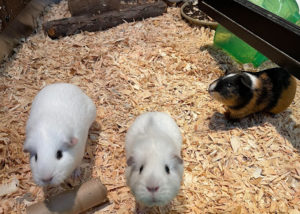Guinea Pig
 Domestic Guinea Pig
Domestic Guinea Pig
Cavia porcellus
Guinea pigs, also known as “cavies,” are part of the rodent order and belong to the family Caviidae, which contains fourteen species. Guinea pigs are by definition domestic and are descended from wild cavies in South America. They were domesticated for meat and fur thousands of years ago in South America and began to be imported to Europe in the 16th century. There are still wild cavies in South America, but the domestic guinea pig is now considered a separate species.
Wild cavies live in big family groups in grassland areas of Central and South America. Guinea pigs in captivity usually get along very well with other guinea pigs and are considered social mammals. For this reason it is highly recommended that guinea pig owners keep two more more guinea pigs at a time. In fact, in Switzerland it is illegal to have just one guinea pig.
Guinea pigs are herbivores. They eat mostly grains with small amounts of greens and other produce. They cannot produce their own vitamin C so need to get it from food — kale, oranges, strawberries and bell pepper are good sources. They have large stomachs and can spend up to six hours per day eating.
Lindsay Wildlife is home to two guinea pigs: Daisy and Pepper. Daisy joined the family in 2020 after her pregnant mom was found abandoned in the woods near Sacramento. Pepper, our youngest guinea pig, was adopted by Lindsay from San Francisco Animal Control in 2021 after being found in a box dumped on the city streets. You’ll find our guinea pig herd in the What’s Wild What’s Not exhibit.
